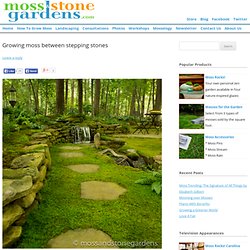

Terracotta Pot. Geometric Pot This design gives a fresh take on the classic terracotta pot, finding a perfect balance between striking contemporary design and traditional material.

Display in multiples and Herb’s irregular form gives the illusion that each pot is unique, creating a landscape of contrasting shapes. Ideal for growing herbs and other small plants. Designed and made in the UK. Materials: slip cast terracotta Dimensions: W 17cm x H 17cm x D 17cm UK Delivery: Free / 3 days Europe Delivery: Slide to the right -> : string gardens. Moss Art. Moss Art Mud Maiden Lost Gardens of Heligan, Cornall, England www.heligan.com Mud Maiden Lost Gardens of Heligan, Cornall, England. www.heligan.com The Giant's Head Lost Gardens of Heligan.

By Susan & Pete Hill. www.heligan.com Mud Maiden (a newer sister to above) By Susan & Pete Hill - Private Collection. www.flixya.com. Rare flowers of the world. Phoenix Flower The Phoenix Flower is prized for its bright petals, of course.

It has no leaves, so it has real trouble making chlorophyll. Because of this, each flower dies, shortly after sunset. However, the seeds it leaves behind have an incredible germination speed, and so, shortly after sunrise, a new, full-size plant grows in the exact same spot as before. This flower was discovered in 1871 by an explorer called Stanley Rourke, deep in the mountains of Peru. Unfortunately he was unable to bring a sample back, and none have since been discovered. Before his death, Rourke also discovered the Transparent Daffodil, the Glass Posy, and the African Chameleon Flower. Double Daisy White daisies usually grow on the bright, sunny sides of mountains. The Double Daisy is a very rare flower that grows only on the very tops of tall mountains, soaking up both the sun and rain.
Gloomy Sponge They have tiny petals (as there's no need for them) and numerous leaves (to pick up every drop of light they can). Japanese Garden and Kura Storage in Hirakawa-City. My colleagues and I went to Hirakawa-City for “Old Houses, Japanese Gardens and Kura Storages Tour” which is an annual tour, and is held only 2 days in the end of May.

If you try to go to Hirakawa-City from Aomori-City by train or bus, it is easier to transfer at Hirosaki-City. Since I don’t like a slow train, we paid extra 510yen to get on the “Resort Shirakami“, which is a popular train to travel around Akita – Goshogawara – Aomori area. Resort Shirakami, a train with a bigger window Box Seat Onoe district in Hirakawa-City is known with the Japanese gardens well taken care of, and well preserved Kura storages. Japanese Garden in Onoe Kura Storage - mainly used to store rice and apples The more layers the window has, the higher class the storage is. In the tour you can visit about 10 private Japanese gardens of old families which are not usually open to the public. Volcano rocks are popular for the garden because they get easily covered with moss, and with the beautiful shapes Like this:
Moss and Stone Gardens. This page pulls together many posts from this blog as a convenient way to cover the basics of moss gardening.

To gain a deeper understanding you can filter the blog post by choosing the category of Moss Education which will contain the information below but also include all of the posts that focus on cultivation techniques. Our main mission at Moss and Stone Gardens‘ blog, is to educate those desiring to learn more about mosses. Our goal is to make it easy for you to understand mosses; to take the mystery out of moss – not the mystic. As a landscape design group specializing in moss and stone gardens, we work with homeowners and design professionals designing with moss. Knowing your Acrocarp from your Pleurocarp INTRODUCTIONAll mosses can be classified as 2 types: Acrocarpous and Pleurocarpous Recently, I asked David Spain, our moss expert, to describe the two types of mosses we are so often writing about.
Acrocarpous mosses have an upright growth habit. Pleurocarp habit Acrocarp habit. Growing moss between stepping stones. Dear David, a.k.a.

Moss Rock, How do I get moss to grow between the stepping stones. I have flagstone. I have shaded it from about 60% of the sun, watered it regularly and added sulfur to the soil. I get a little moss and some lichen, but I want more moss. Jenn Dear Jenn, The secret is out, growing moss takes only watering. The key to establishing moss anywhere is to water. Look for pluerocarp mosses and transplant between the stones, then water until they fill in, that’s it! Pay attention to your sunlight conditions and look for mosses growing in the same exposure to better your success, collect different species and mix them to further ensure one species will like the conditions. A note about moss between close set stones, this tends to be an area where drying out occurs quickly, so watering techniques are most critical, so keep ‘em moist, but don’t drown!